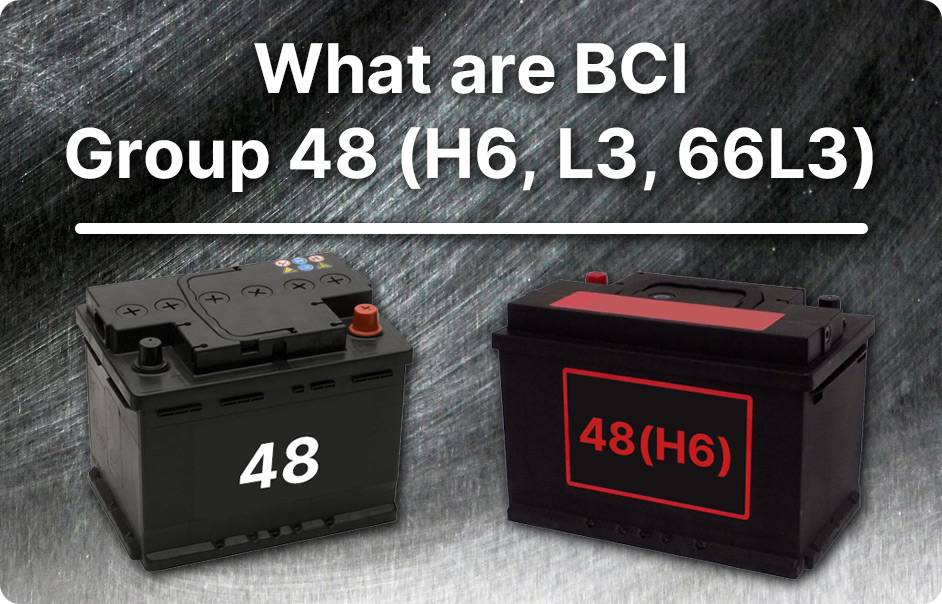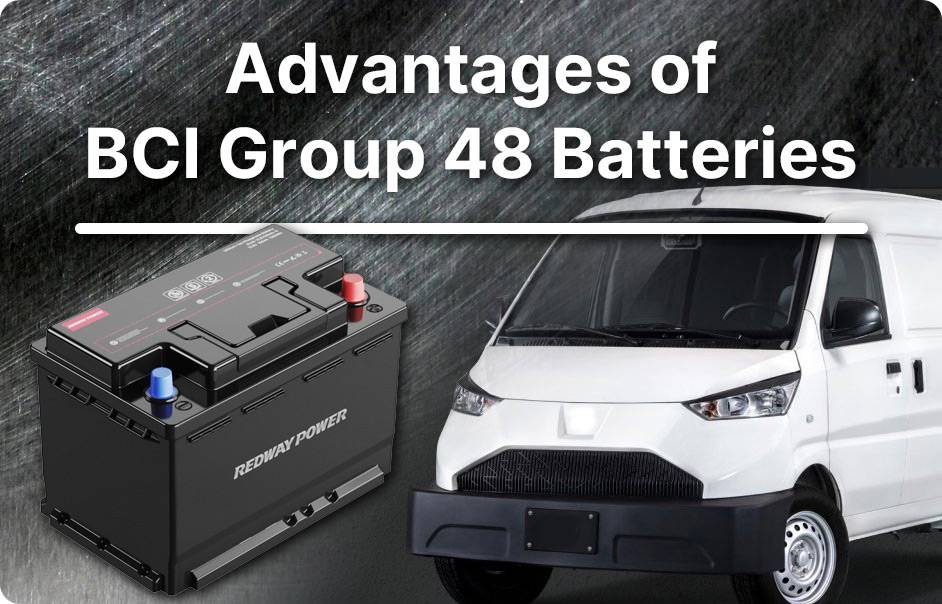BCI Group 48 batteries, equivalent to DIN H6 (L3) and EN 66L3, offer standardized dimensions suitable for various automotive and industrial applications.
What are BCI Group 48 (H6, L3, 66L3) Batteries?
BCI Group 48 batteries are considered equivalent to DIN H6 (L3) and EN 66L3 batteries.
BCI Group 48 batteries typically have physical dimensions of 12 1/16 x 6 7/8 x 7 9/16 inches (306 x 175 x 192 mm), whereas DIN H6 (L3) and EN 66L3 batteries have maximum dimensions of 278 x 175 x 190 mm.

This results in a difference of approximately 28 mm (~1.1 inches) in length between these two standards. Battery compartments designed for BCI Group 48 batteries can accommodate DIN H6/L3 (EN 66L3) batteries, but the reverse may present challenges. However, BCI Battery Group 98R batteries, with physical dimensions of 283 x 175 x 190 mm, offer a closer match to the DIN H6 (L3) and EN 66L3 batteries. Although slightly longer, it’s only by 5 mm (~0.2 inches).
Specifications and Features of Group 48 (H6, L3, 66L3) Batteries
Group 48 batteries are tailored to precise dimensions outlined by the Battery Council International (BCI), ensuring compatibility with various vehicle models. With a typical capacity spanning from 70 to 85 ampere-hours (Ah), Group 48 batteries determine their energy storage capability. For cold-weather reliability, these batteries boast Cold Cranking Amps (CCA) ratings ranging from 600 to 800 amps, guaranteeing dependable starts even in chilly conditions.
Many Group 48 batteries feature maintenance-free designs, sparing users from electrolyte checks or water refills. Combining reliable starting power, maintenance-free operation, and durability, Group 48 batteries stand as versatile options for a wide range of vehicles.
What are advantages of BCI Group 48 (H6, L3, 66L3) Batteries?
Advantages of BCI Group 48 (H6, L3, 66L3) batteries include:
- Versatility: BCI Group 48 batteries are versatile and can be used in a wide range of vehicles, including cars, trucks, and marine applications.
- Standardized Size: These batteries have standardized dimensions, ensuring compatibility with various vehicle models and battery compartments.
- Reliable Performance: Group 48 batteries offer reliable starting power and electrical performance, meeting the demands of modern vehicles and electronic systems.
- Availability: BCI Group 48 batteries are widely available at automotive stores, online retailers, and battery distributors, making them easy to find and purchase when needed.
- Compatibility: These batteries are compatible with a variety of charging systems and can withstand a range of environmental conditions, making them suitable for use in different climates and applications.
What are the Applications of BCI Group 48 (H6, L3, 66L3) Batteries?
BCI Group 48 (H6, L3, 66L3) batteries find applications in various vehicles and equipment, including:

- Cars: Group 48 batteries are commonly used in cars and light trucks for starting the engine and powering onboard electronics.
- Trucks: They are also suitable for use in trucks, providing reliable starting power for diesel and gasoline engines.
- Marine: Group 48 batteries are used in marine applications such as boats and yachts, providing starting power for marine engines and auxiliary systems.
- Industrial Equipment: These batteries can be found in industrial equipment such as forklifts, generators, and agricultural machinery, where reliable starting power is essential.
- Recreational Vehicles (RVs): Group 48 batteries are used in RVs and motorhomes to power the engine, as well as auxiliary systems such as lighting, appliances, and entertainment devices.
- Emergency Backup Power: They are also used in backup power systems for homes and businesses, providing reliable power during outages or emergencies.
Overall, BCI Group 48 batteries are versatile power sources suitable for a wide range of applications in automotive, marine, industrial, and recreational settings.
Best Sellers of BCI Group 48 (H6, L3, 66L3) Batteries in 2024
Below is a chart detailing some of the most popular Group 48 batteries along with their key features:
| Model | Battery Type Cell Type |
Capacity (Ah) RC (Min) |
CCA MCA |
Weight (lbs/kg) Review |
| ACDelco 48AGM Professional | Starting AGM |
70 120 |
760 – |
45.5 lbs; 20.6 kg – |
| Deka 9A48 Intimidator | Dual Purpose AGM |
70 120 |
760 875 |
45 lbs; 20.4 kg – |
| Delphi BU9048 MaxStart | Starting AGM |
70 120 |
760 – |
45.5 lbs; 20.6 kg – |
| MARXON Group 48 H6 L3 | Starting AGM |
70 120 |
760 – |
46.53 lbs; 21.1 kg – |
| NorthStar NSB-AGM48 | Dual Purpose AGM |
69 135 |
775 880 |
48 lbs; 21.8 kg – |
| Odyssey Battery 48-720 Battery | Dual Purpose AGM |
69 130 |
723 842 |
48 lbs; 21.8 kg – |
| Optima Batteries DH6 YellowTop | Dual Purpose AGM |
72 140 |
800 928 |
54 lbs; 24.5 kg |
| UPLUS Group 48 Battery | Starting AGM |
70 120 |
760 – |
46.53 lbs; 21.1 kg – |
| Weize Group 48 Battery | Dual Purpose AGM |
70 120 |
760 – |
47.5 lbs; 21.5 kg – |
| XingCell PH6 Lithium | Starting LiFePO4 |
48 115 |
560 – |
15.8 lbs; 7.16 kg – |
| XS Power D4800 | Dual Purpose AGM |
60 120 |
– 815 |
47.6 lbs; 21.6 kg – |
Please note: Amazon affiliate links in the ‘Model’ column open in new windows for the most up-to-date prices and offers.
BCI Group 48 (H6, L3, 66L3) batteries typically boast a nominal capacity ranging from 60 to 70 Ah, 720 to 800 CCA, 800 to 930 MCA, and RC values between 120 and 140 minutes.
ACDelco and Delphi manufacture Group 48 batteries primarily intended for starting applications. While they can handle discharges from onboard electronics, they are not considered true dual-purpose batteries.
On the other hand, NorthStar, Odyssey, and Optima produce dual-purpose Group 48 batteries capable of cranking large engines while also enduring numerous charging and discharging cycles.
The XS Power D4800 is also a dual-purpose battery, but its main purpose is to power audio and multimedia devices when the engine is off.
FAQs
What are the physical dimensions of BCI Group 48 batteries?
BCI Group 48 batteries typically measure 12 1/16 x 6 7/8 x 7 9/16 inches (306 x 175 x 192 mm).
Are BCI Group 48 batteries compatible with DIN H6 (L3) and EN 66L3 batteries?
Yes, BCI Group 48 batteries are considered equivalent to DIN H6 (L3) and EN 66L3 batteries.
Can BCI Group 48 batteries be used interchangeably with DIN H6 (L3) batteries?
Yes, although there may be slight differences in dimensions, BCI Group 48 batteries can generally be used interchangeably with DIN H6 (L3) batteries.
What are the advantages of BCI Group 48 batteries compared to other battery groups?
BCI Group 48 batteries offer compatibility with DIN H6 (L3) and EN 66L3 standards, standardized sizing, and versatility for various applications.

Which applications commonly use BCI Group 48 batteries?
BCI Group 48 batteries are commonly used in automotive, marine, and industrial applications.
Are there any specific considerations when selecting BCI Group 48 batteries for a vehicle or equipment?
Consider compatibility with the intended vehicle or equipment, specific performance requirements, and environmental conditions when selecting BCI Group 48 batteries.


